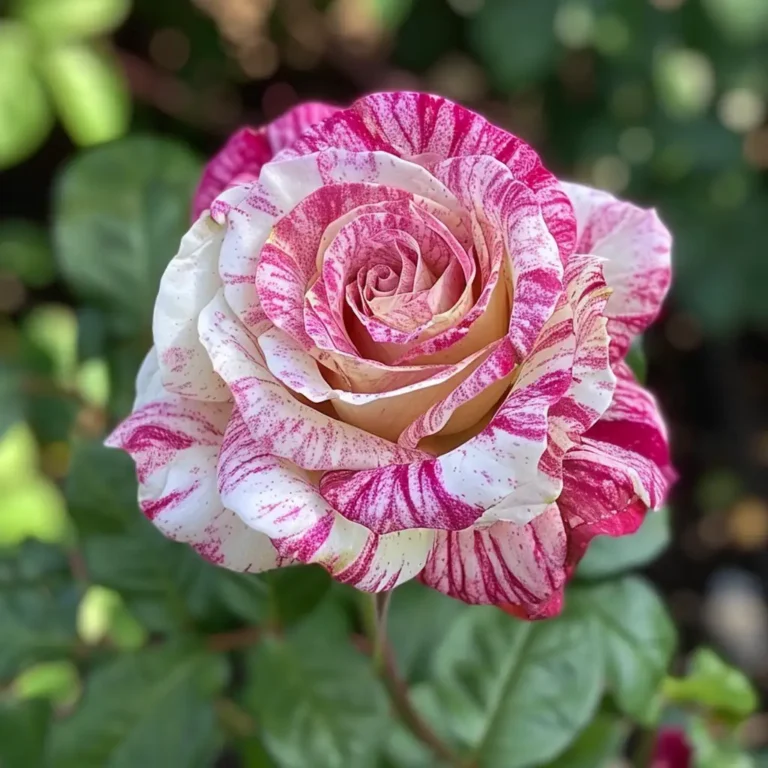Introduction to Peppermint Swirl Rose
The Peppermint Swirl Rose is a captivating hybrid tea rose, renowned for its unique red and white striped blooms. This rose variety has garnered significant attention from gardeners and rose enthusiasts due to its striking appearance and delightful fragrance. Understanding the intricacies of this rose can help you cultivate a vibrant and healthy garden.
History and Origin
The Peppermint Swirl Rose boasts a rich history, originating from meticulous breeding efforts aimed at producing a visually appealing and resilient rose. Introduced to the market in the late 20th century, it quickly became a favorite for both amateur and professional gardeners.
Botanical Description
Physical Characteristics
- Height: 24-36 inches (60-90 cm)
- Bloom Size: Large, 4-5 inches in diameter
- Petal Count: Full, with 26-40 petals
- Color: A blend of red and white, creating a peppermint swirl effect
- Bloom Shape: Cupped
Fragrance
- Mild, spice fragrance that adds a sensory dimension to its visual appeal.
Growing Conditions and Requirements
To ensure the healthy growth of the Peppermint Swirl Rose, it is crucial to provide optimal growing conditions.
Soil Type and Preparation
- Soil: Well-drained, loamy soil with a pH of 6.0 to 6.5.
- Preparation: Enrich the soil with organic matter like compost or well-rotted manure.
Watering Needs
- Maintain consistent moisture levels, ensuring the soil is neither too dry nor waterlogged.
- Water deeply once or twice a week, depending on weather conditions.
Sunlight Requirements
- Prefers full sun, requiring at least 6 hours of direct sunlight daily.
- In hotter climates, some afternoon shade can protect the blooms from scorching.
Climate Adaptability
- Thrives in USDA hardiness zones 5-9.
- Can withstand mild frost, but requires protection in colder climates.
Planting and Care Tips
Planting Techniques
- Spacing: Plant 24-36 inches apart to allow for adequate air circulation.
- Depth: Ensure the graft union is just above the soil surface.
Fertilization
- Use a balanced rose fertilizer, applied in early spring and mid-summer.
- Avoid high-nitrogen fertilizers as they promote foliage growth over blooms.
Pruning and Deadheading
- Prune in early spring to remove dead or diseased wood.
- Regularly deadhead spent blooms to encourage continuous flowering.
Pest and Disease Management
- Common pests include aphids, spider mites, and Japanese beetles.
- Diseases such as black spot and powdery mildew can be prevented with proper spacing and air circulation.
Bloom Cycle and Seasonal Care
The Peppermint Swirl Rose blooms in flushes throughout the growing season. Understanding its bloom cycle can help you provide the necessary care at each stage.
Bloom Times
- Initial bloom in late spring.
- Reblooms periodically until the first frost.
Seasonal Care Tips
- Spring: Prune and fertilize to promote new growth.
- Summer: Maintain regular watering and deadheading.
- Fall: Prepare for winter by reducing watering and applying mulch to protect the roots.
Landscape Uses and Design Ideas
The Peppermint Swirl Rose is versatile in landscape design. Its striking appearance makes it suitable for various garden styles.
Incorporation in Garden Designs
- Ideal for rose gardens, mixed borders, and as a focal point in landscape designs.
- Pairs well with perennials like lavender, salvia, and catmint, which enhance its beauty and fragrance.
Companion Plants
- Choose plants that do not compete for nutrients and provide complementary colors.
- Good companions include lavender, catmint, and geraniums.
Propagation Methods
Propagating the Peppermint Swirl Rose can be done through several methods, ensuring you have a thriving rose garden.
Seed Propagation
- Less common due to the variability in offspring.
- Requires patience as seeds take time to germinate and grow.
Cutting Propagation
- Most popular method.
- Take cuttings in late spring or early summer and root in a well-draining medium.
Grafting Techniques
- Used by professional growers.
- Involves joining a Peppermint Swirl Rose cutting to a hardy rootstock.
Common Issues and Solutions
Despite its resilience, the Peppermint Swirl Rose can encounter some common issues. Addressing these promptly can ensure the health of your plant.
Common Pests
- Aphids: Treat with insecticidal soap or neem oil.
- Spider Mites: Increase humidity and use miticides if necessary.
Common Diseases
- Black Spot: Prevent with proper spacing and fungicides.
- Powdery Mildew: Ensure good air circulation and use sulfur-based fungicides.
Frequently Asked Questions
How to Maintain Vibrant Colors?
- Ensure the rose receives adequate sunlight.
- Use balanced fertilizers and maintain proper watering practices.
Best Practices for Winter Care?
- Mulch around the base to protect the roots.
- In colder climates, consider covering the plant with burlap or a rose cone.
How to Deal with Common Pests?
- Regularly inspect the plant for signs of infestation.
- Use organic or chemical treatments as necessary.
Conclusion
The Peppermint Swirl Rose is a stunning addition to any garden, offering both beauty and fragrance. By understanding its growing conditions, care requirements, and common issues, you can cultivate a healthy and thriving rose plant. Embrace the charm of this unique hybrid tea rose and enjoy its captivating blooms throughout the season.

